Seawater Reverse Osmosis Performance Decline Caused by Short-Term Elevated Feed Water Temperature
Abstract
:1. Introduction
2. Materials and Methods
2.1. Pilot Plant Details
2.2. Operating Conditions
2.3. Seawater Conditions
- Temperature: unregulated, 24–35 °C
- pH—natural, 8.3
- Total dissolved solids (TDS)—natural, approx. 41,500 ppm
2.4. Operating Parameters
- Feed temperature ~25–40 °C (after HP pump).
- Feed conductivity ~60.0 mS/cm.
- Feed flow ~7.5 m3/h.
- Recovery—40% constant.
- Permeate flow—3.0 m3/h constant and no permeate split operation.
- Brine flow—4.5 m3/h.
- Membrane flux calculated 2 × 400 + 5 × 440 ft2 and 3.0 m3/h = 10.75 LMH.
- Operation conditions were maintained by brine and feed control valves.
- SWRO inlet temperature during recirculation operation was maintained by circulating the seawater through a water-cooled exchanger, which was operated automatically through a PLC.
2.5. Experiment Conditions
3. Results
4. Discussion
5. Conclusions
- A SWRO feed water temperature of 40 °C, even during a short period of 7 days, caused a permanent performance decline, as illustrated by a strong specific energy consumption (SEC) increase of 7.5%.
- A 7.5% increase in SEC, depending on the plant size, translates into an additional operating cost of USD 250,000 a year for a 60,000 m3/day production capacity plant to USD 2.5 M a year for a 600,000 m3/day capacity plant [47].
- There are financial consequences, in addition to contractual implications, for the use of additional energy. Since the energy required by the plant is defined during project development, it may require payment of an inflated tariff for the additional consumption.
Supplementary Materials
Author Contributions
Funding
Institutional Review Board Statement
Informed Consent Statement
Data Availability Statement
Acknowledgments
Conflicts of Interest
References
- Gude, V.G.; Nirmalakhandan, N.; Deng, S. Desalination using solar energy: Towards sustainability. Energy 2011, 36, 78–85. [Google Scholar] [CrossRef]
- Mekonnen, M.M.; Hoekstra, A.Y. Four billion people facing severe water scarcity. Sci. Adv. 2016, 2, e1500323. [Google Scholar] [CrossRef] [PubMed]
- Berktay, A. Environmental approach and influence of red tide to desalination process in the Middle East region. Int. J. Chem. Environ. Eng. 2011, 2. [Google Scholar]
- Ghaffour, N.; Missimer, T.M.; Amy, G.L. Combined desalination, water reuse, and aquifer storage and recovery to meet water supply demands in the GCC/MENA region. Desalination Water Treat. 2013, 51, 38–43. [Google Scholar] [CrossRef]
- Tahir, F.; Baloch, A.A.; Ali, H. Resilience of Desalination Plants for Sustainable Water Supply in Middle East. In Sustainability Perspectives: Science, Policy and Practice; Springer: Berlin/Heidelberg, Germany, 2020; pp. 303–329. [Google Scholar]
- Das, R.; Arunachalam, S.; Ahmad, Z.; Manalastas, E.; Mishra, H. Bio-inspired gas-entrapping membranes (GEMs) derived from common water-wet materials for green desalination. J. Membr. Sci. 2019, 117185. [Google Scholar] [CrossRef]
- Das, R.; Arunachalam, S.; Ahmad, Z.; Manalastas, E.; Syed, A.; Buttner, U.; Mishra, H. Proof-of-Concept for Gas-Entrapping Membranes Derived from Water-Loving SiO2/Si/SiO2 Wafers for Green Desalination. JoVE 2020, e60583. [Google Scholar] [CrossRef]
- Ghaffour, N.; Missimer, T.M.; Amy, G.L. Technical review and evaluation of the economics of water desalination: Current and future challenges for better water supply sustainability. Desalination 2013, 309, 197–207. [Google Scholar] [CrossRef]
- Ghaffour, N. The challenge of capacity-building strategies and perspectives for desalination for sustainable water use in MENA. Desalination Water Treat. 2009, 5, 48–53. [Google Scholar] [CrossRef]
- Altmann, T.; Das, R. Process improvement of sea water reverse osmosis (SWRO) and subsequent decarbonization. Desalination 2021, 499, 114791. [Google Scholar] [CrossRef]
- Jones, E.; Qadir, M.; van Vliet, M.T.H.; Smakhtin, V.; Kang, S.M. The state of desalination and brine production: A global outlook. Sci. Total Environ. 2019, 657, 1343–1356. [Google Scholar] [CrossRef]
- Voutchkov, N. Energy use for membrane seawater desalination – current status and trends. Desalination 2018, 431, 2–14. [Google Scholar] [CrossRef]
- Yousry, A.; Ridwan, M.G.; Altmann, T.; Rousseva, A.; Azab, K.; Das, R. Performance Model for Reverse Osmosis. Chem. Eng. Res. Des. 2022, in press. [Google Scholar] [CrossRef]
- Karabelas, A.; Koutsou, C.; Kostoglou, M.; Sioutopoulos, D. Analysis of specific energy consumption in reverse osmosis desalination processes. Desalination 2018, 431, 15–21. [Google Scholar] [CrossRef]
- Pillai, S.; Santana, A.; Das, R.; Shrestha, B.R.; Manalastas, E.; Mishra, H. A molecular to macro level assessment of direct contact membrane distillation for separating organics from water. J. Membr. Sci. 2020, 608, 118140. [Google Scholar] [CrossRef]
- Busch, M.; Mickols, W.E. Reducing energy consumption in seawater desalination. Desalination 2004, 165, 299–312. [Google Scholar] [CrossRef]
- Zhu, A.; Rahardianto, A.; Christofides, P.D.; Cohen, Y. Reverse osmosis desalination with high permeability membranes—cost optimization and research needs. Desalination Water Treat. 2010, 15, 256–266. [Google Scholar] [CrossRef]
- Wilf, M. Design consequences of recent improvements in membrane performance. Desalination 1997, 113, 157–163. [Google Scholar] [CrossRef]
- Bartels, C.R.; Andes, K. Consideration of energy savings in SWRO. Desalination Water Treat. 2013, 51, 717–725. [Google Scholar] [CrossRef]
- Zhu, A.; Christofides, P.D.; Cohen, Y. Minimization of energy consumption for a two-pass membrane desalination: Effect of energy recovery, membrane rejection and retentate recycling. J. Membr. Sci. 2009, 339, 126–137. [Google Scholar] [CrossRef]
- Mishra, H.; Arunachalam, S.N.M.; Domingues, E.M.; Das, R. Perfluorocarbon-free membranes for membrane distillation. U.S. Patent Application No. 17/056,809, 2021. [Google Scholar]
- Okamoto, Y.; Lienhard, J.H. How RO membrane permeability and other performance factors affect process cost and energy use: A review. Desalination 2019, 470, 114064. [Google Scholar] [CrossRef]
- Mehdizadeh, H.; Dickson, J.M.; Eriksson, P.K. Temperature effects on the performance of thin-film composite, aromatic polyamide membranes. Ind. Eng. Chem. Res. 1989, 28, 814–824. [Google Scholar] [CrossRef]
- Kimura, S. Analysis of reverse osmosis membrane behaviors in a long-term verification test. Desalination 1995, 100, 77–84. [Google Scholar] [CrossRef]
- Gonzalez-Gil, G.; Behzad, A.R.; Farinha, A.S.; Zhao, C.; Bucs, S.S.; Buijs, P.; Vrouwenvelder, J. Clinical Autopsy of a Reverse Osmosis Membrane Module. Front. Chem. Eng. 2021, 3, 23. [Google Scholar] [CrossRef]
- Davenport, D.M.; Ritt, C.L.; Verbeke, R.; Dickmann, M.; Egger, W.; Vankelecom, I.F.J.; Elimelech, M. Thin film composite membrane compaction in high-pressure reverse osmosis. J. Membr. Sci. 2020, 610, 118268. [Google Scholar] [CrossRef]
- Peterson, R.; Greenberg, A.; Bond, L.; Krantz, W. Use of ultrasonic TDR for real-time noninvasive measurement of compressive strain during membrane compaction. Desalination 1998, 116, 115–122. [Google Scholar] [CrossRef]
- McGovern, R.K.; McConnon, D.; Lienhard, J.H. The effect of very high hydraulic pressure on the permeability and salt rejection of reverse osmosis membranes. In Proceedings of the 2015 IDA World Congress on Desalination and Water Reuse, San Diego, CA, USA, 4 September 2015. [Google Scholar]
- Davenport, D.M.; Deshmukh, A.; Werber, J.R.; Elimelech, M. High-Pressure Reverse Osmosis for Energy-Efficient Hypersaline Brine Desalination: Current Status, Design Considerations, and Research Needs. Environ. Sci. Technol. Lett. 2018, 5, 467–475. [Google Scholar] [CrossRef]
- Alexiadis, A.; Wiley, D.E.; Vishnoi, A.; Lee, R.H.K.; Fletcher, D.F.; Bao, J. CFD modelling of reverse osmosis membrane flow and validation with experimental results. Desalination 2007, 217, 242–250. [Google Scholar] [CrossRef]
- Ladner, D.A.; Subramani, A.; Kumar, M.; Adham, S.S.; Clark, M.M. Bench-scale evaluation of seawater desalination by reverse osmosis. Desalination 2010, 250, 490–499. [Google Scholar] [CrossRef]
- Hereher, M.E. Assessment of Climate Change Impacts on Sea Surface Temperatures and Sea Level Rise—The Arabian Gulf. Climate 2020, 8, 50. [Google Scholar] [CrossRef]
- Nesterov, O.; Temimi, M.; Fonseca, R.; Nelli, N.R.; Addad, Y.; Bosc, E.; Abida, R. Validation and statistical analysis of the Group for High Resolution Sea Surface Temperature data in the Arabian Gulf. Oceanologia 2021, 63, 497–515. [Google Scholar] [CrossRef]
- Alawad, K.A.; Al-Subhi, A.M.; Alsaafani, M.A.; Alraddadi, T.M. Decadal variability and recent summer warming amplification of the sea surface temperature in the Red Sea. PLOS ONE 2020, 15, e0237436. [Google Scholar] [CrossRef]
- Cattaert, A. High pressure pump efficiency determination from temperature and pressure measurements. In Proceedings of the 2007 IEEE Power Engineering Society Conference and Exposition in Africa-PowerAfrica, Johannesburg, South Africa, 16–20 July 2007; pp. 1–8. [Google Scholar]
- Koutsou, C.P.; Kritikos, E.; Karabelas, A.J.; Kostoglou, M. Analysis of temperature effects on the specific energy consumption in reverse osmosis desalination processes. Desalination 2020, 476, 114213. [Google Scholar] [CrossRef]
- Saeed, M.O.; Jamaluddin, A.; Tisan, I.; Lawrence, D.; Al-Amri, M.; Chida, K. Biofouling in a seawater reverse osmosis plant on the Red Sea coast, Saudi Arabia. Desalination 2000, 128, 177–190. [Google Scholar] [CrossRef]
- Strickland, J.D.H.; Parsons, T.R. A Practical Handbook of Seawater Analysis; Fisheries Research Board of Canada: Ottawa, ON, Canada, 1972. [Google Scholar]
- Goosen, M.F.A.; Sablani, S.S.; Al-Maskari, S.S.; Al-Belushi, R.H.; Wilf, M. Effect of feed temperature on permeate flux and mass transfer coefficient in spiral-wound reverse osmosis systems. Desalination 2002, 144, 367–372. [Google Scholar] [CrossRef]
- Water, D.; Solutions, P. FILMTEC™ Reverse Osmosis Membranes Technical Manual. 2013. Available online: http://msdssearch.dow.com/PublishedLiteratureDOWCOM/dh_08db/0901b803808db77d.pdf (accessed on 22 July 2022).
- Jin, X.; Jawor, A.; Kim, S.; Hoek, E.M.V. Effects of feed water temperature on separation performance and organic fouling of brackish water RO membranes. Desalination 2009, 239, 346–359. [Google Scholar] [CrossRef]
- Aghajani, M.; Wang, M.; Cox, L.M.; Killgore, J.P.; Greenberg, A.R.; Ding, Y. Influence of support-layer deformation on the intrinsic resistance of thin film composite membranes. J. Membr. Sci. 2018, 567, 49–57. [Google Scholar] [CrossRef]
- Handge, U.A. Analysis of compaction and life-time prediction of porous polymer membranes: Influence of morphology, diffusion and creep behaviour. Polym. Int. 2017, 66, 521–531. [Google Scholar] [CrossRef]
- Kitano, H.; Takeuchi, K.; Ortiz-Medina, J.; Ito, I.; Morelos-Gomez, A.; Cruz-Silva, R.; Yokokawa, T.; Terrones, M.; Yamaguchi, A.; Hayashi, T.; et al. Enhanced desalination performance in compacted carbon-based reverse osmosis membranes. Nanoscale Adv. 2020, 2, 3444–3451. [Google Scholar] [CrossRef]
- Sharabati, J.-A.-D.; Guclu, S.; Erkoc-Ilter, S.; Koseoglu-Imer, D.Y.; Unal, S.; Menceloglu, Y.Z.; Ozturk, I.; Koyuncu, I. Interfacially polymerized thin-film composite membranes: Impact of support layer pore size on active layer polymerization and seawater desalination performance. Sep. Purif. Technol. 2019, 212, 438–448. [Google Scholar] [CrossRef]
- Lakner, G.; Lakner, J.; Racz, G.; Kłos, M. Temperature dependence modelling of reverse osmosis. Desalin. Water Treat 2020, 192, 431–436. [Google Scholar] [CrossRef]
- Desaldata, I. The IDA Water Security Handbook 2020–2021; Media Analytics Ltd.: Oxford, UK, 2020; pp. 1–41. [Google Scholar]
- Wolfs, M.; Woodroffe, S. Structuring and financing international BOO/BOT desalination projects. J. Struct. Financ. 2002, 7, 19–24. [Google Scholar] [CrossRef]
- Safar, M.; Jafar, M.; Abdel-Jawad, M.; Bou-Hamad, S. Standardization of RO membrane performance. Desalination 1998, 118, 13–21. [Google Scholar] [CrossRef]
- Zhao, Y.; Taylor, J.S. Assessment of ASTM D 4516 for evaluation of reverse osmosis membrane performance. Desalination 2005, 180, 231–244. [Google Scholar] [CrossRef]
- Toray Industries, I. TorayTrak. Available online: https://www.water.toray/knowledge/tool/trak/ (accessed on 7 July 2022).
- Ruiz-García, A.; Nuez, I. Long-term performance decline in a brackish water reverse osmosis desalination plant. Predictive model for the water permeability coefficient. Desalination 2016, 397, 101–107. [Google Scholar] [CrossRef]
- Farhat, N.M.; Vrouwenvelder, J.S.; Van Loosdrecht, M.C.M.; Bucs, S.S.; Staal, M. Effect of water temperature on biofouling development in reverse osmosis membrane systems. Water Res. 2016, 103, 149–159. [Google Scholar] [CrossRef]
- Jawor, A.; Hoek, E.M.V. Effects of feed water temperature on inorganic fouling of brackish water RO membranes. Desalination 2009, 235, 44–57. [Google Scholar] [CrossRef]
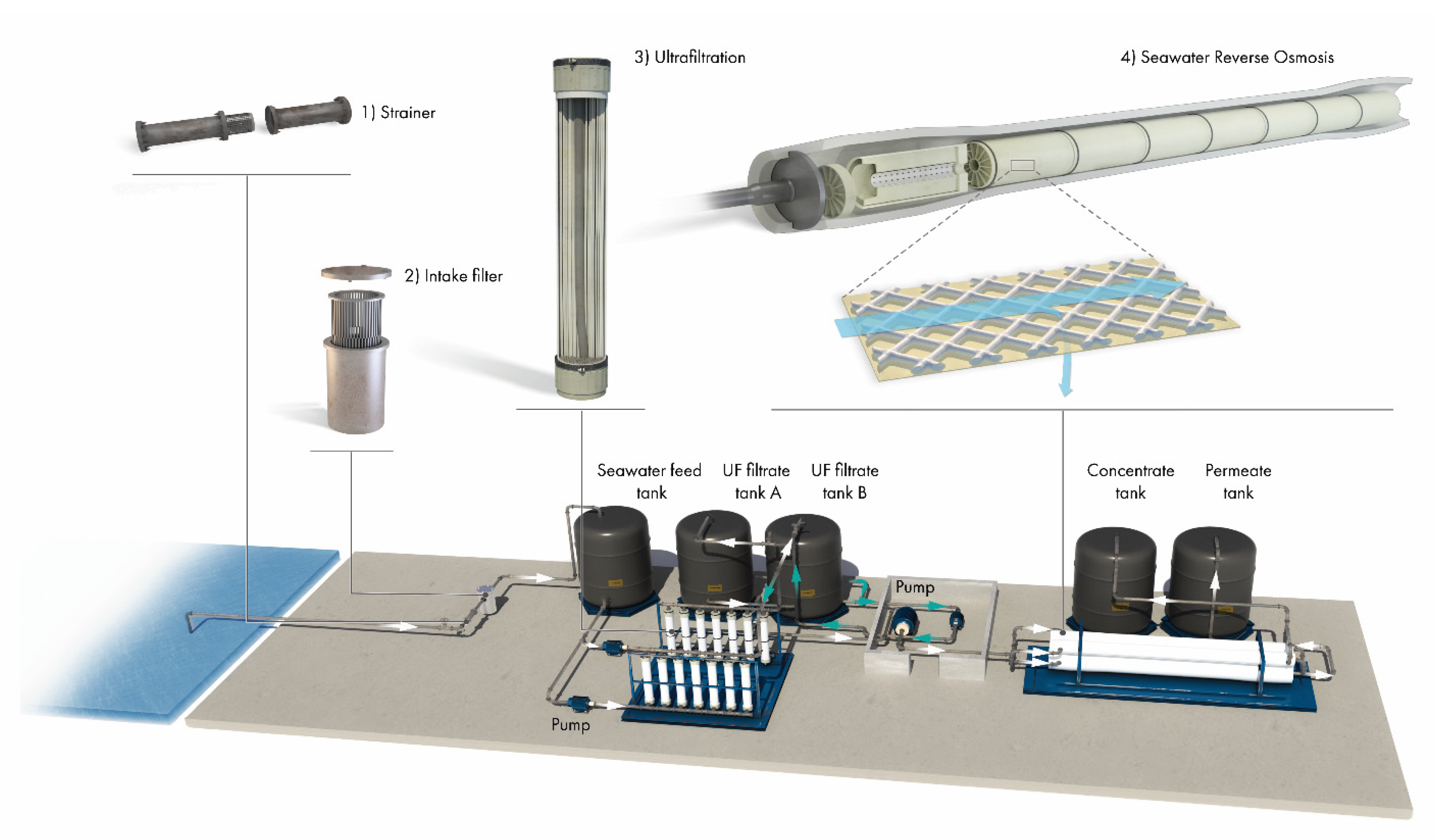

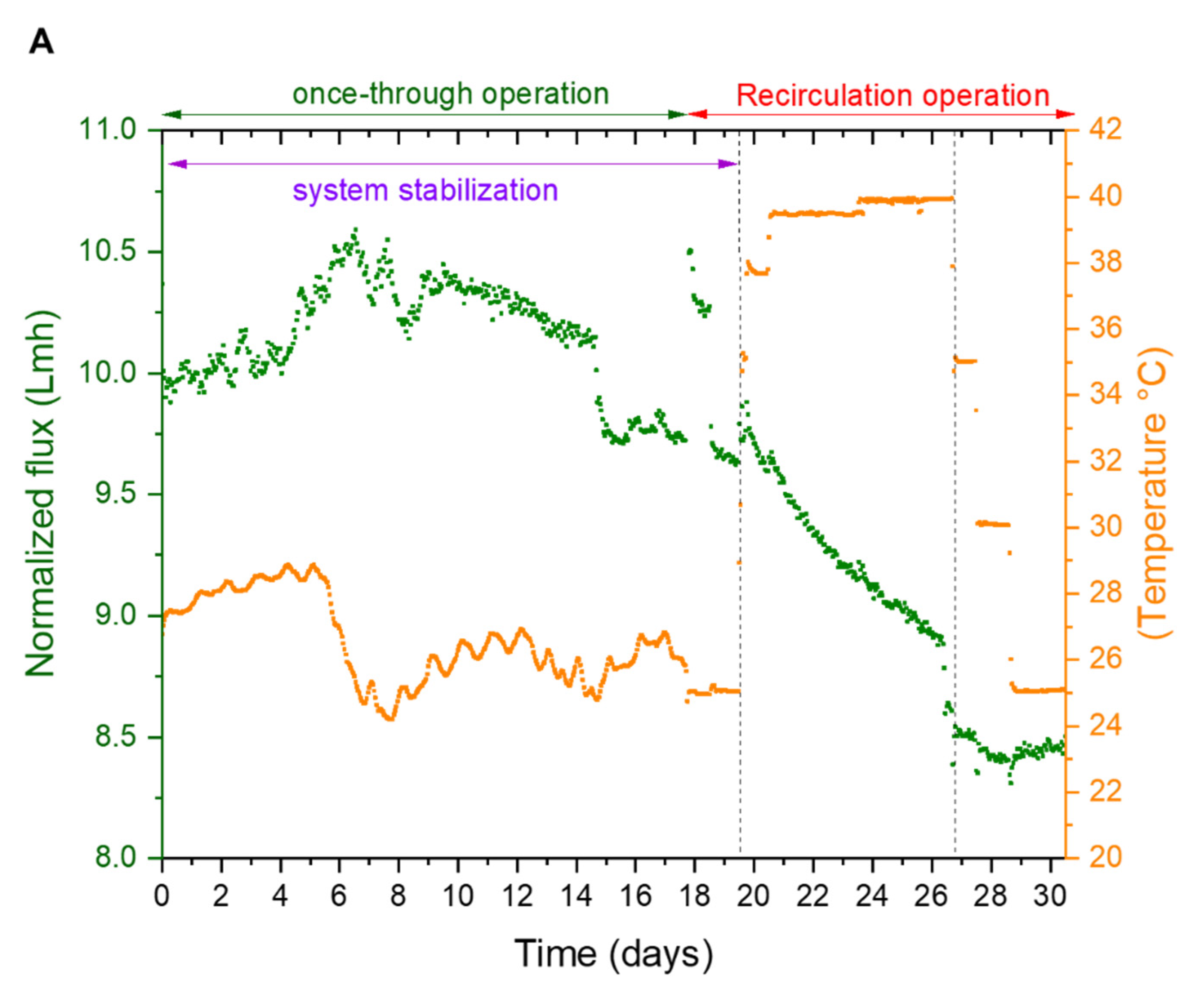
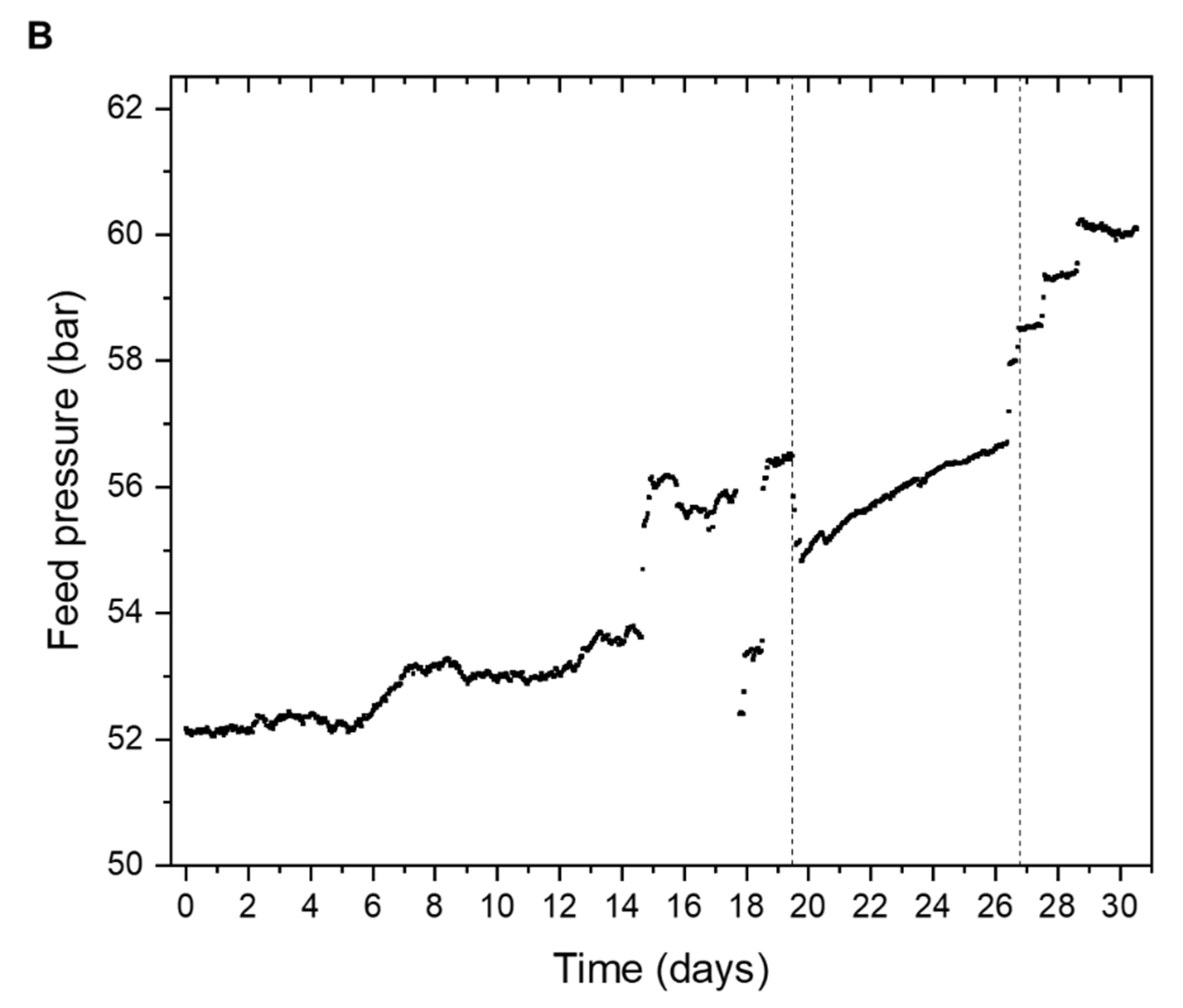
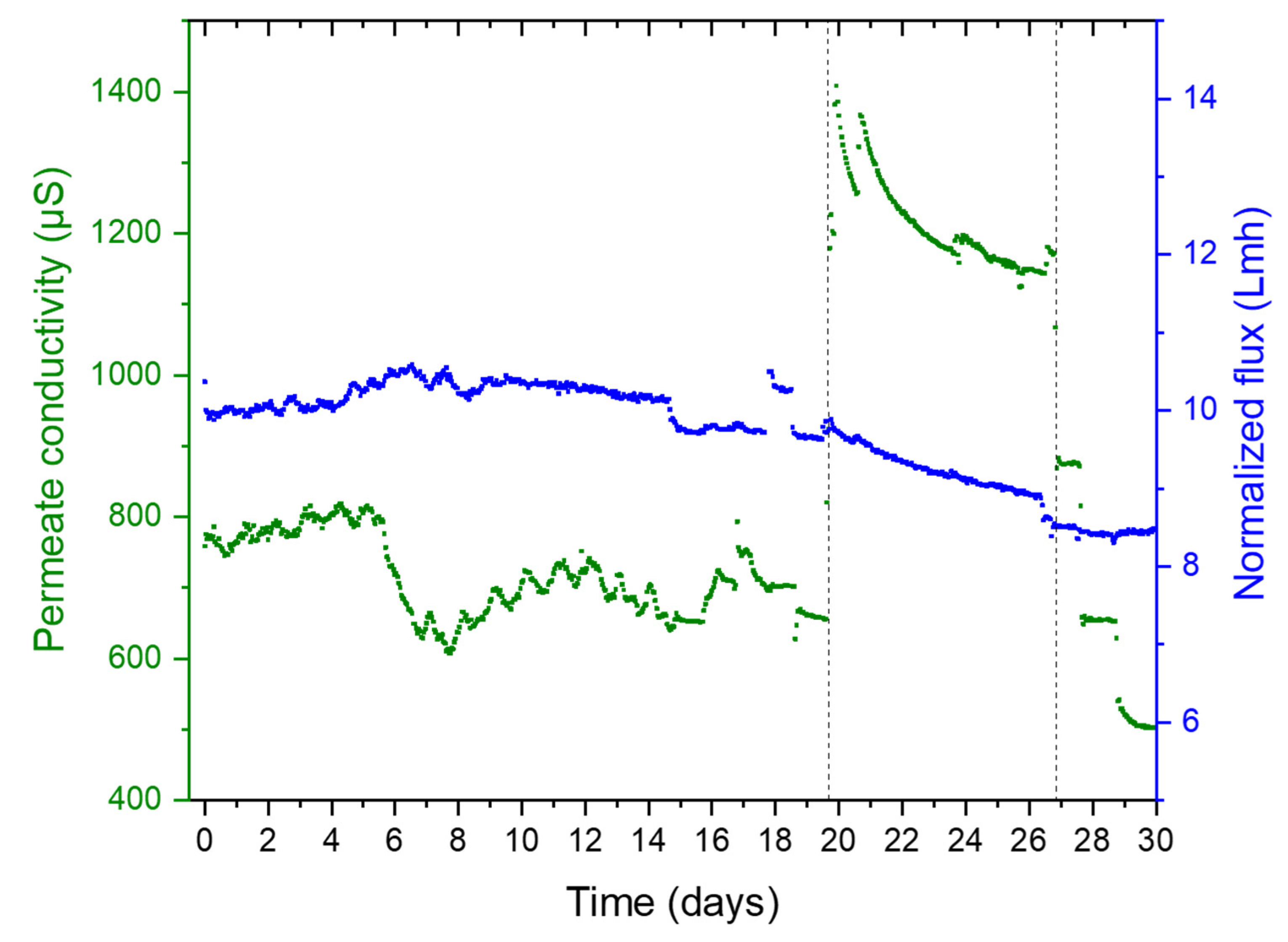
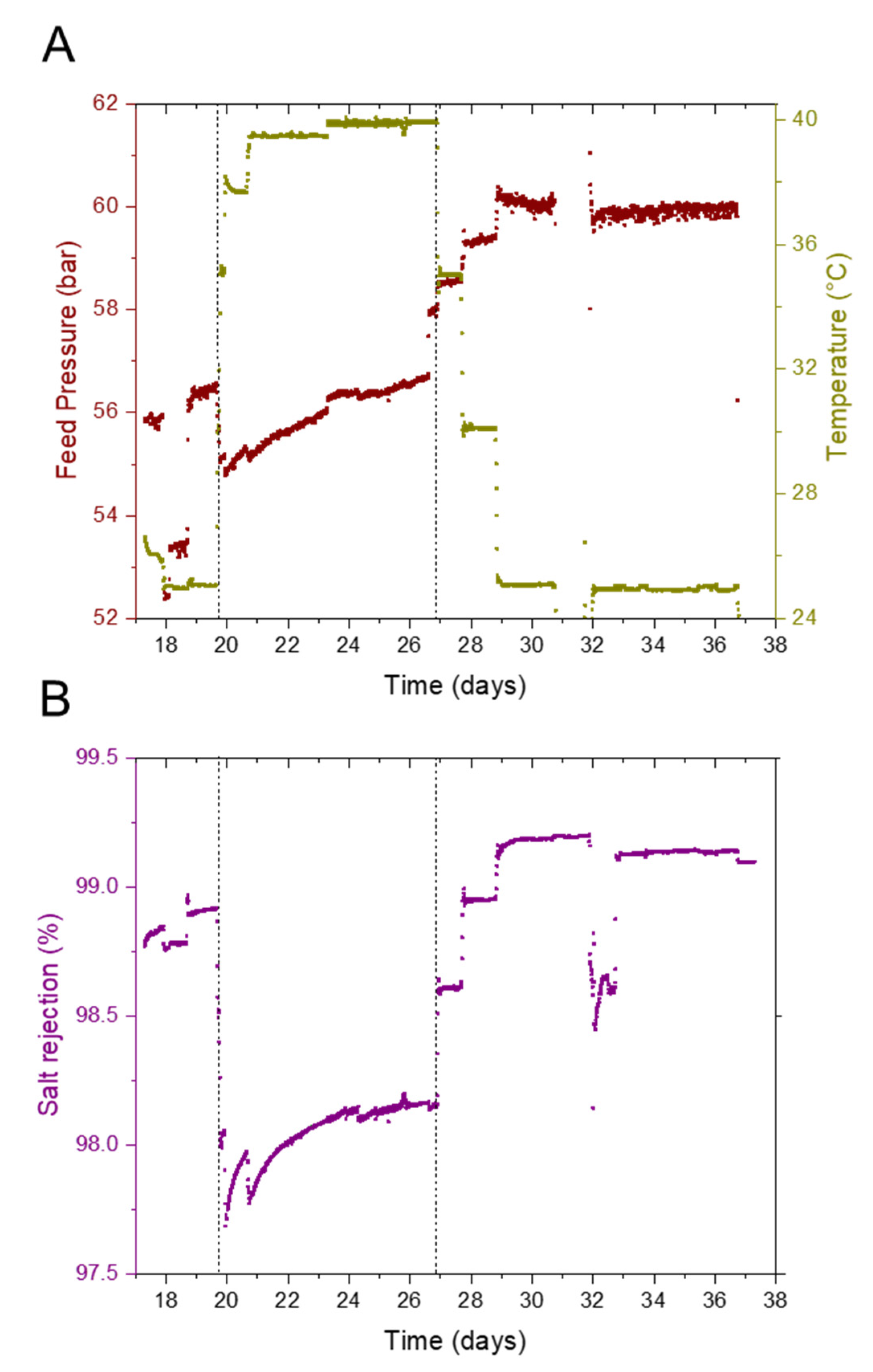
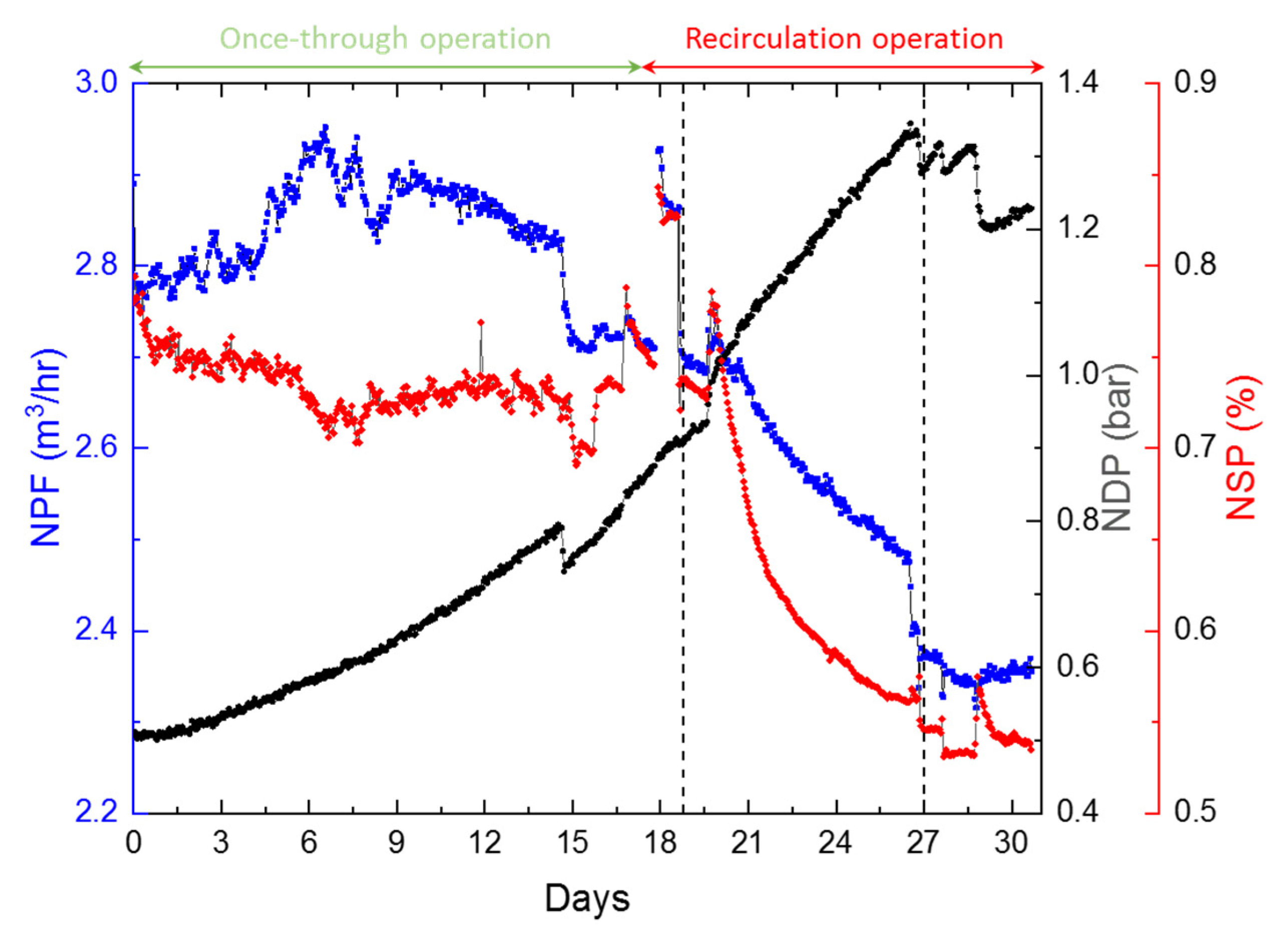
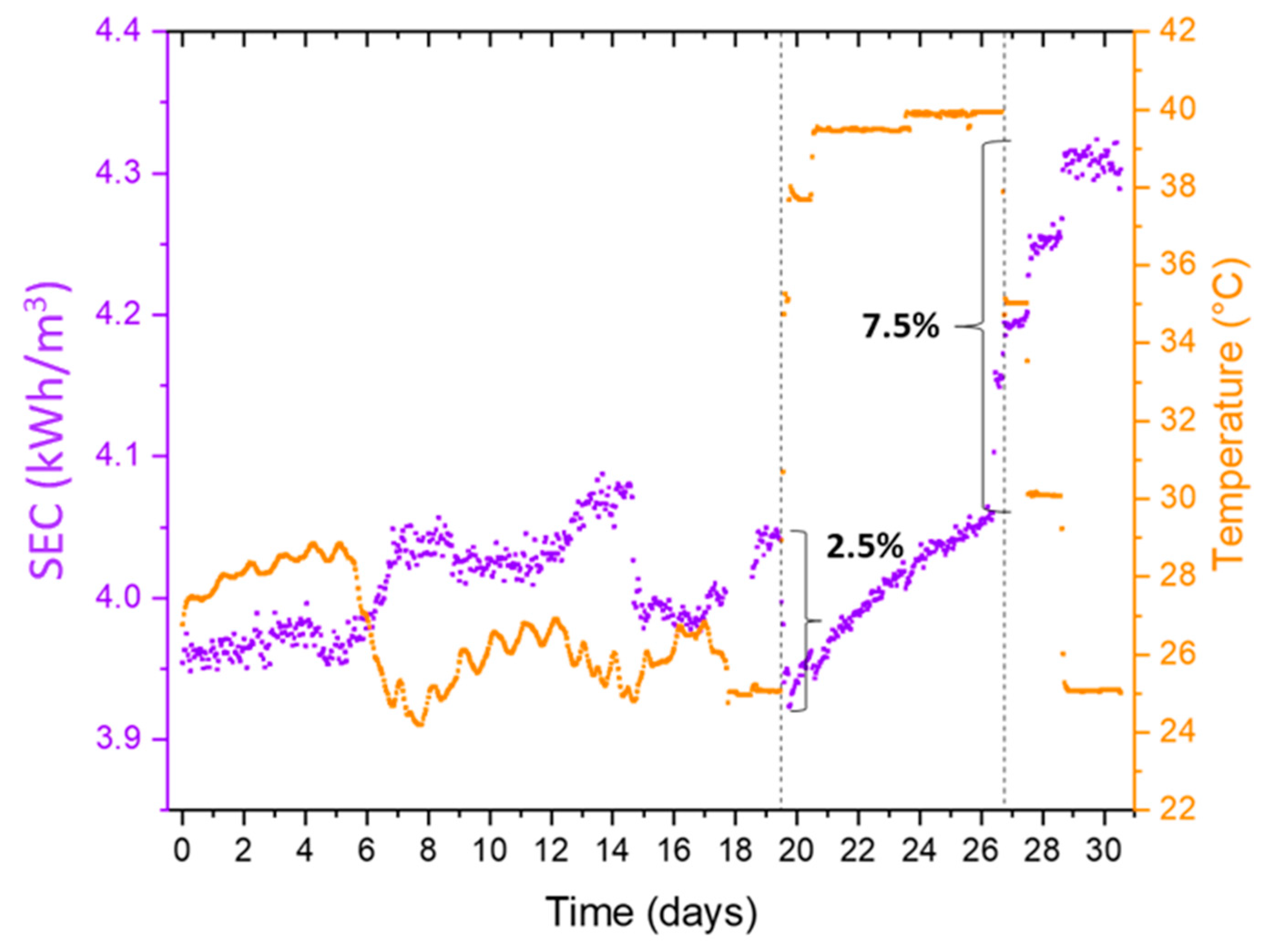
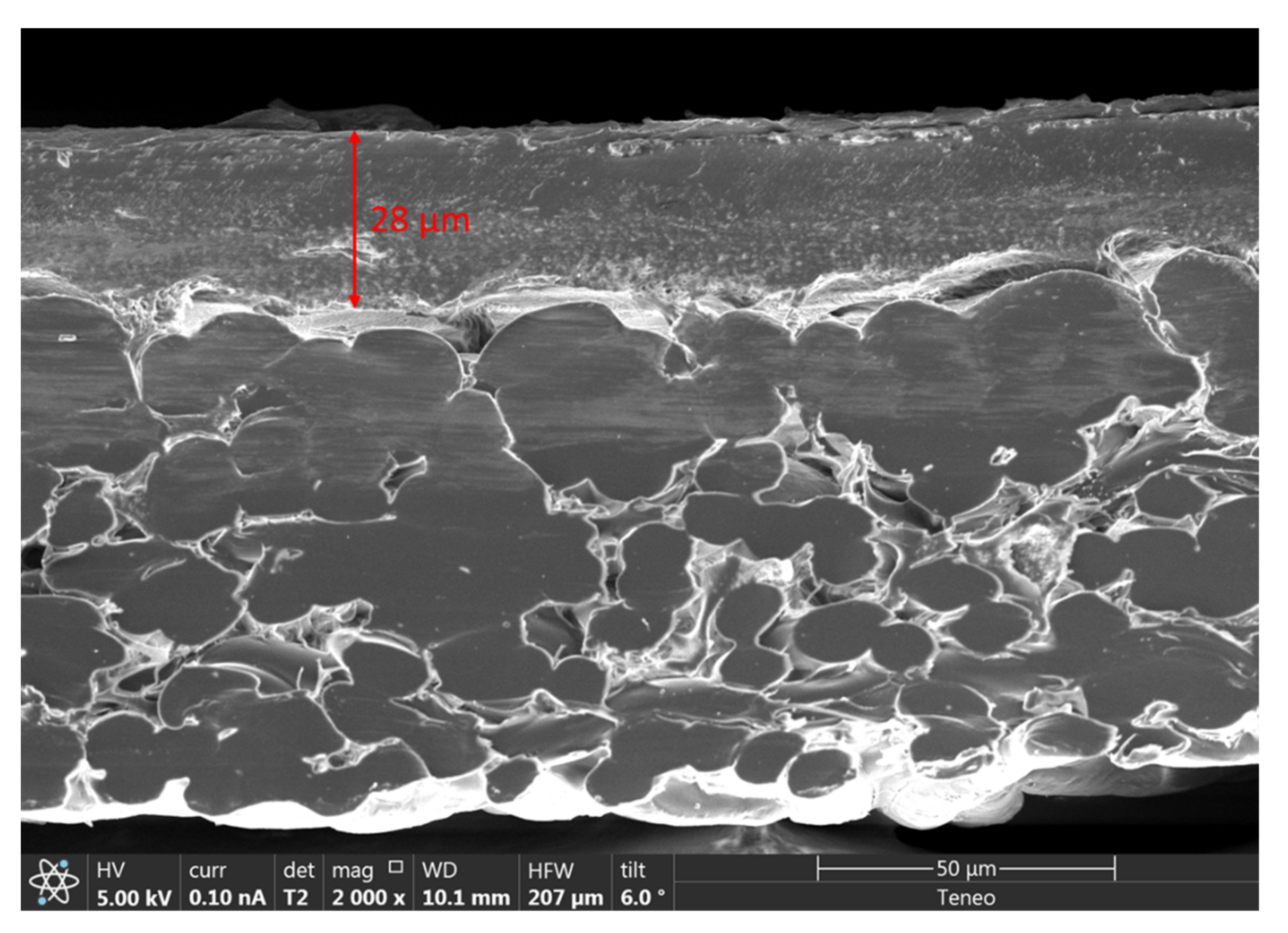
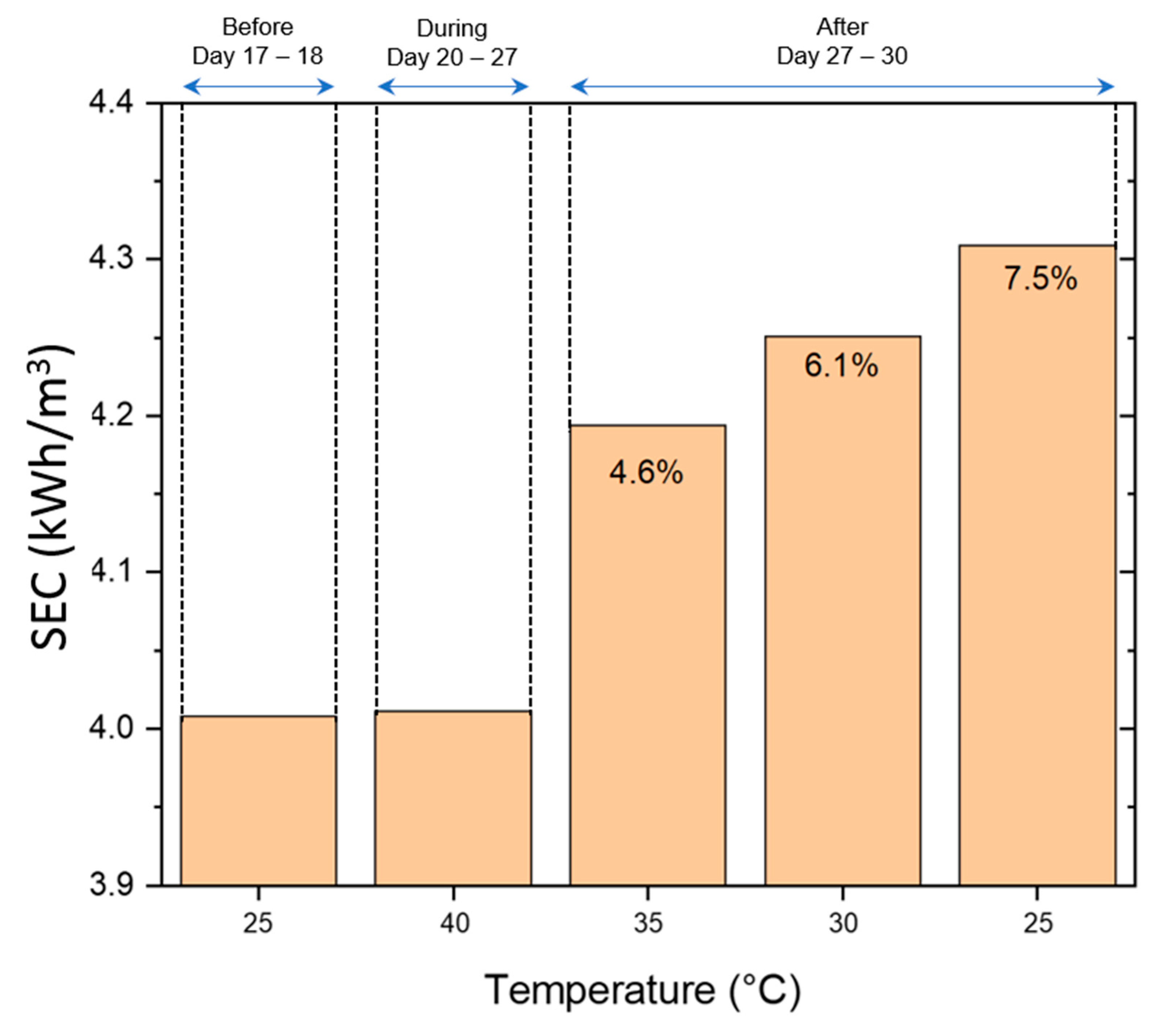
| Cations | Unit | Value | Anions | Unit | Value | ||
|---|---|---|---|---|---|---|---|
| Calcium | Ca++ | mg/L | 485 | Bicarbonate | HCO3− | mg/L | 153 |
| Magnesium | Mg++ | mg/L | 1649 | Chloride | Cl− | mg/L | 22,918 |
| Sodium | Na+ | mg/L | 12,549 | Bromide | Br− | mg/L | 78.29 |
| Potassium | K+ | mg/L | 464 | Sulfate | SO4−− | mg/L | 3220 |
| Strontium | Sr++ | mg/L | 5.32 | Fluoride | F− | mg/L | 1.34 |
| Barium | Ba++ | mg/L | 0.01 | Carbonate | CO3−− | mg/L | 6.0 |
| Nitrate | NO3− | mg/L | 1.3 | ||||
| Other parameters | |||||||
| TDS | mg/L | 41,540 | Boron | B | mg/L | 4.9 | |
| Conductivity | µS/cm | 59,800 | Silica | Si | mg/L | 1.4 | |
| pH | - | 8.24 | TOC | C | mg/L | 3.0 | |
| Temperature | T | °C | 25 | Density | ρ | g/L | 1028 |
| Phase | Operation Phase Description | Water Temperature (°C) | Time (day) | Operation Mode | |
|---|---|---|---|---|---|
| Once Through | Recirculation | ||||
| 1a | Stabilization of membranes | Not regulated * | 0 to 16 | X | |
| 1b | 25 | 17–18 | X | ||
| 2 | Temperature increase | From 25 to 40 | 19–20 | X | |
| 3 | Operation at high temperature | 40 | 20–27 | X | |
| 4 | Temperature decrease reaching 25 °C | 35, 30, and 25 | 27–30 | X | |
| Element | Value (mg/m2) |
|---|---|
| Fe | 191.1 |
| Mg | 17.6 |
| Ni | 13.7 |
| Mn | 1.4 |
Publisher’s Note: MDPI stays neutral with regard to jurisdictional claims in published maps and institutional affiliations. |
© 2022 by the authors. Licensee MDPI, Basel, Switzerland. This article is an open access article distributed under the terms and conditions of the Creative Commons Attribution (CC BY) license (https://creativecommons.org/licenses/by/4.0/).
Share and Cite
Altmann, T.; Buijs, P.J.; Farinha, A.S.F.; Borges, V.R.P.; Farhat, N.M.; Vrouwenvelder, J.S.; Das, R. Seawater Reverse Osmosis Performance Decline Caused by Short-Term Elevated Feed Water Temperature. Membranes 2022, 12, 792. https://doi.org/10.3390/membranes12080792
Altmann T, Buijs PJ, Farinha ASF, Borges VRP, Farhat NM, Vrouwenvelder JS, Das R. Seawater Reverse Osmosis Performance Decline Caused by Short-Term Elevated Feed Water Temperature. Membranes. 2022; 12(8):792. https://doi.org/10.3390/membranes12080792
Chicago/Turabian StyleAltmann, Thomas, Paulus J. Buijs, Andreia S. F. Farinha, Vitor R. Proença Borges, Nadia M. Farhat, Johannes S. Vrouwenvelder, and Ratul Das. 2022. "Seawater Reverse Osmosis Performance Decline Caused by Short-Term Elevated Feed Water Temperature" Membranes 12, no. 8: 792. https://doi.org/10.3390/membranes12080792
APA StyleAltmann, T., Buijs, P. J., Farinha, A. S. F., Borges, V. R. P., Farhat, N. M., Vrouwenvelder, J. S., & Das, R. (2022). Seawater Reverse Osmosis Performance Decline Caused by Short-Term Elevated Feed Water Temperature. Membranes, 12(8), 792. https://doi.org/10.3390/membranes12080792







